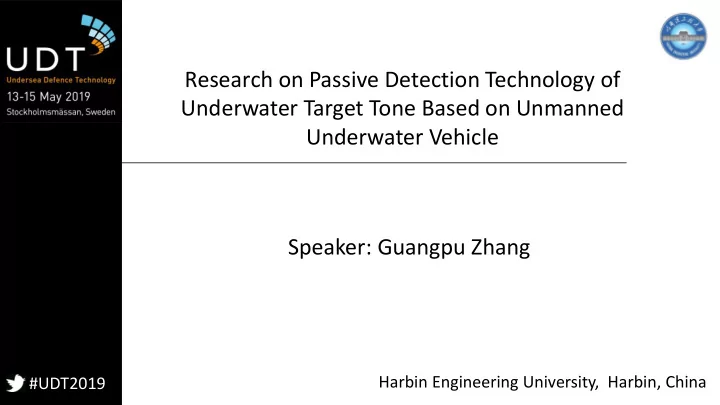

Research on Passive Detection Technology of Underwater Target Tone Based on Unmanned Underwater Vehicle Speaker: Guangpu Zhang Harbin Engineering University, Harbin, China #UDT2019
Background Freedom from harsh conditions Strong Flexibility UUV Low cost-effectiveness ratio Easy to cluster Passive UUV sonar system Detection Detection #UDT2019 Tonal signals radiated from underwater vessels
Background high strength Tonal Small loss of Phase signals propagation stability The tonal signals radiated from underwater vessels are of great significance for UUV sonar systems to detect the underwater objects. #UDT2019
h n ( ) Signal model & Problem Signal model: Tonal target h n ( ) Beamforming technique Interferences Tone detection h n ( ) Sensor Fig. 1. UUV sonar array signal reception schematic Problem: denotes the DOA of tone h n ( ) the main beam direction and is usually fast time-varying in deviates from the DOA the UUV or target motion-case of tonal target. #UDT2019
Signal model & Problem cannot be effectively h n ( ) x n 0 ( ) Z Z 1 1 TDLs 0 estimated in advance × × × w w w L -1,0 l ,0 0,0 + + x ( ) n Z m Z 1 1 resulting in improper pre- m × × × w w w delays to be selected 0, m l m , L -1, m y n ( ) m + + + x 1 ( ) n M Z Z 1 1 M 1 A pointing deviation of the × × × w w w L -1, M 1 l M , 1 0, M 1 main beam will appear. + + Fig. 2 . Conventional broadband beamformer Unable to detect tone #UDT2019
Proposed technique Basic idea: The main idea of this technique is to introduce the self- tuning filtering characteristics of the adaptive line enhancer (ALE) into the broadband beamforming technique Advantages: The technique does not need to estimate the DOA of tone in advance and can adaptively form a real-time tracking beam pointed to the DOA of tonal target. #UDT2019
Proposed technique upper path (n) d n ( ) ( ) n x TDLs W q y n ( - ) TDLs W lower path LMS Fig. 3. The proposed self-tracking beamformer block diagram The fixed weight vector is chosen so as to W q eliminate signal of interest in W q (Convex optimization tools) LMS algorithm 2 W H 𝐗 Minimize E d (n) W X n - #UDT2019
Simulations Sensor number: M =20 Subregion of interest: Ө =50 ֯ ~130 ° Target DOA varies from 75 ֯ to 120 ֯ a over 15 seconds The main-beam of the self-tracking beamformer can adaptively track the target DOA b Fig. 1 Beam pattern at target frequency bin versus time a Conventional beamformer (pointed to100 ֯ ) b Self-tracking beamformer #UDT2019
Simulations Tonal signal of the target can be observed over the entire time range and the interferences as a well as the broadband noise are a suppressed efficiently b Fig. 2 Time-frequency analysis of wideband beamformer output a Conventional beamformer (pointed to100 ° ) b Self-tracking beamformer #UDT2019
Conclusion The proposed technique can adaptively form a real-time tracking beam pointed to the DOA of tonal target and avoids the beam pointing deviation due to UUV-platform swinging, the rotational motion of UUV, the fast maneuvering of target or UUV, etc. #UDT2019
Recommend
More recommend